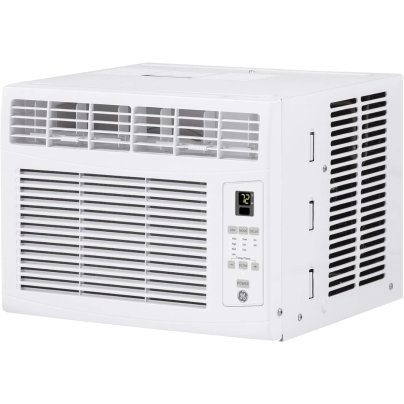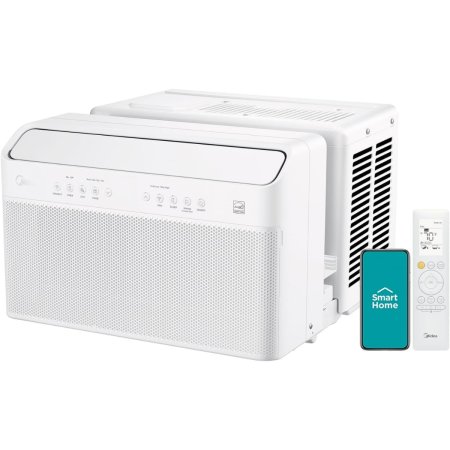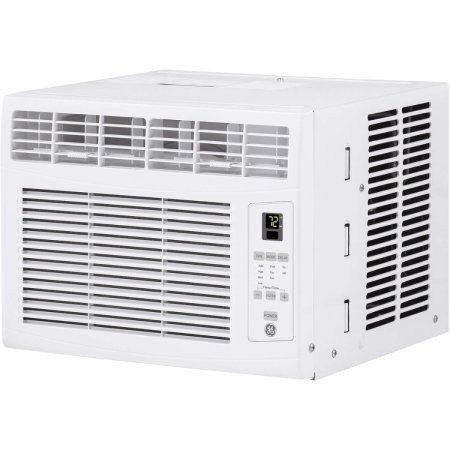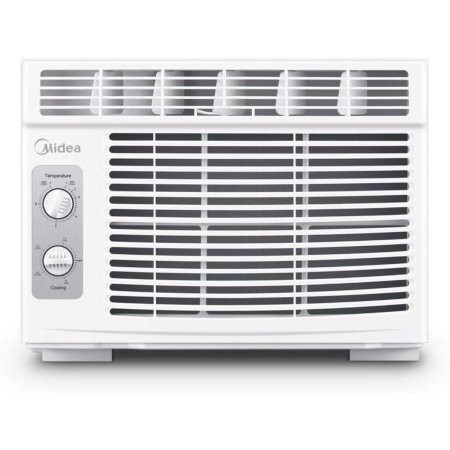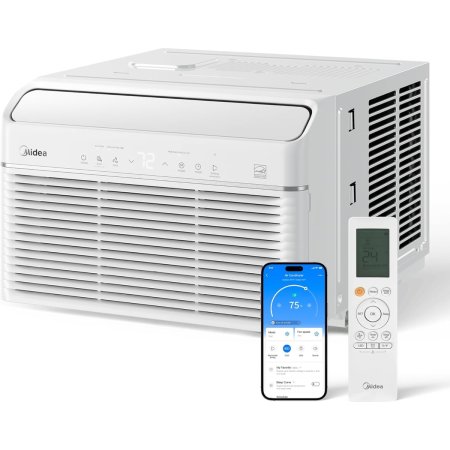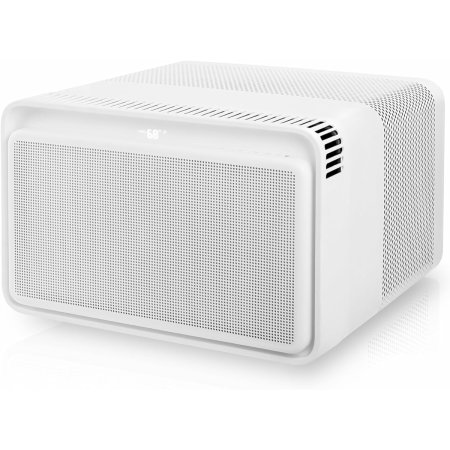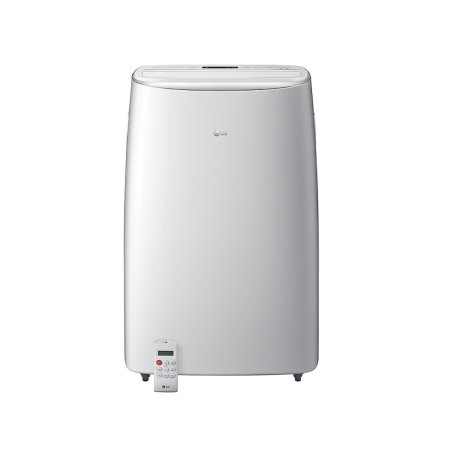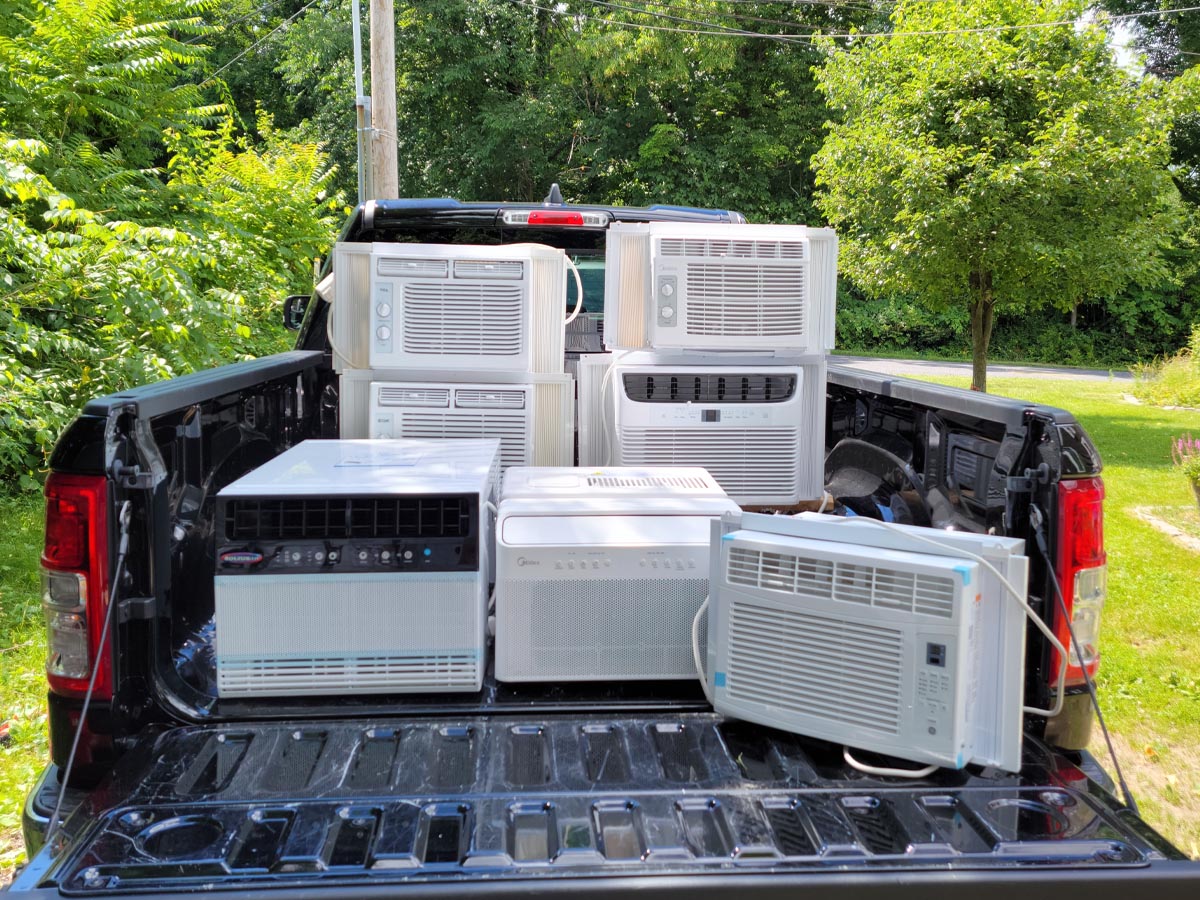
We may earn revenue from the products available on this page and participate in affiliate programs. Learn More ›
Those who live in older homes without the comfort and convenience of central air conditioning understand just how hard it can be to sleep in a hot bedroom. While a fan or evaporative cooler can help, a better solution is a small window air conditioner. These diminutive but adequately powerful appliances produce around 5,000 British thermal units (BTUs) of energy, which is enough to cool most bedrooms. Smaller than more powerful units, they’re capable of fitting in window openings as narrow as 14 inches high by 21 inches wide while also being much more affordable.
Small air conditioners range from top-of-the-line models with LED displays, remote controls, fancy operating modes, and even smart technology to budget-priced models with simple analog controls. With so many options on the market, it can be difficult to determine which model is the right one for you. To help, we put the following models through hands-on testing on some of the hottest days of the year to determine how well they cool, how well their features work, and even how quietly they run. Our top recommendation goes to the Midea 8,000 BTU U-Shaped Air Conditioner thanks to its updated and modern design along with near-silent operation.
This guide will examine the factors to consider when choosing the best small window air conditioner and review some of the best models on the market. Keep reading to learn more about what we found out.
- BEST OVERALL: Midea 8,000 BTU U-Shaped Air Conditioner
↓ Jump to Review - BEST BANG FOR THE BUCK: GE 6,000 BTU Electronic Window Air Conditioner
↓ Jump to Review - BEST FOR SMALL WINDOWS: Midea 5,000 BTU EasyCool Window Air Conditioner
↓ Jump to Review - BEST FOR LARGER ROOMS: Midea 12,000 BTU Smart Window Air Conditioner
↓ Jump to Review - BEST QUIET: Windmill 8,000 BTU Smart Air Conditioner
↓ Jump to Review - BEST PORTABLE: LG 10,000 BTU Dual Inverter Portable Air Conditioner
↓ Jump to Review

How We Tested the Best Small Window Air Conditioners
Testing a group of small window air conditioners took quite a bit of work, and we compared them to one another on several levels. First, we had to break the air conditioners up into separate categories, as comparing a 5,000 BTU model to a 10,000 BTU air conditioner is unfair. We had three 5,000 BTU models; two 6,000 BTU models; one 8,000-BTU model; and one 10,000-BTU model to compare, so we were as systematic as possible.
We installed the 5,000 BTU models in bedrooms first. We compared the process of assembling them (which were remarkably similar) as well as how quickly they could cool the room in the first hour. Then, we moved on to the 6,000 BTU units, which were on totally different pages when it came to installation and design, so we installed them in different spaces, comparing their installation, noise, and features. Finally, we set up the 8,000-BTU model, as well as the larger 10,000 BTU air conditioner, and compared their installation procedures, features, and dimensions.
Comparing cooling proved to be fruitless, as these models were all effective but totally different in terms of output. However, this test did provide us with the information we needed to compare features and installation procedures. We then gave models awards based on their strengths but noted where they may fall short for some shoppers.
| Testing Stats | |
| Products tested | 9 |
| Time spent testing | 3 to 4 hours each |
| Tests performed | 5 to 6 |
| Price range | $160 to $650 |
Our Top Picks
The list below consists of the best small window air conditioners on the market. It includes basic models for the budget minded, efficient units with Energy Star certifications, and advanced air conditioners with cutting-edge technology. Any of the air conditioners below is a good pick for making a bedroom more comfortable in the summertime.
Note: We measured the smallest units to ensure shoppers were able to find something to fit small windows. The other models are designed to fit standard windows at least 28 inches wide.
Best Overall
Midea 8,000 BTU U-Shaped Air Conditioner
Product Specs
- Size: 8,000 BTUs
- Display and setting type: Digital
- Additional features: U-shaped design, remote control, Wi-Fi
Our Ratings: Installation 3/5;Performance 5/5; Noise 5/5; Ease of Cleaning 5/5; Value 5/5
What We Like
- Allows in more light than a typical air conditioner
- Extremely quiet compared to any other model
- Handsome design looks sleek and modern
What We Don’t Like
- Installation is not easy
With its innovative U-shaped design, this Midea air conditioner solves one of the biggest gripes about window air conditioners—noise. Rather than fit in the window space, requiring the window to be open a foot or more, this 8,000 BTU model straddles the window, allowing it to close between the blower and the compressor. With the noisy compressor on the other side of the glass, this air conditioner produces 42 decibels, which is slightly noisier than a library.
This design also has the effect of creating a much tighter seal between the window and the outside, making it 35 percent more energy efficient than standard window units (which helps to offset its significantly higher price tag). In addition to having all the requisite modes of a higher-end air conditioner, including sleep, energy saver, and auto shutoff, this model is also a smart device, capable of connecting to a home’s Wi-Fi for control via a smart device or virtual assistant.
In testing, we found that installing this air conditioner took some effort. It comes with several brackets, pieces of hardware, foam strips, and other components that are a little confusing, even with the QR-code directions. However, once installed, this machine is easy to enjoy. It’s so quiet that it’s barely noticeable. The display is also very attractive, and using the remote is a snap. Its design allows more light into the room than typical window air conditioners, and we liked that we could tuck our curtains behind the AC to promote a bit more privacy.
Get the Midea U-shaped small window air conditioner at Amazon or The Home Depot.
Best Bang For The Buck
GE 6,000 BTU Electronic Window Air Conditioner
Product Specs
- Size: 6,000 BTUs
- Display and setting type: Digital
- Additional features: Remote control
Our Ratings: Installation 5/5;Performance 4/5; Noise 5/5; Ease of Cleaning 5/5; Value 5/5
What We Like
- Cools rooms without breaking the bank
- Small, compact unit is easy to install
- Digital controls are simple to use
What We Don’t Like
- Small display can be difficult to read
With enough power to cool most bedrooms and controls that make setting the temperature a snap, this affordable window air conditioner is one of the best all-around models on the market. Its 6,000 BTU output sets it just above the power envelope of most smaller air conditioning units, which have 5,000 BTUs, giving it just enough extra oomph to cool spaces up to 250 square feet.
The controls for this AC unit are also an upgrade. A digital display allows for precise temperature settings, and a remote control adds convenience. While this model isn’t Energy Star certified, it just misses the mark with an energy-efficiency rating of 11. Despite its larger compressor, this model is compact and able to fit windows as narrow as 21.875 inches wide with a minimum opening of 13.375 inches.
During testing, we found the GE air conditioner to be a good choice for bedrooms and other smaller spaces. It’s quiet compared to most other 5,000 or 6,000 BTU air conditioners. It proved easy to install, and working through the digital settings is intuitive. The main issue with this model is that the display is very small, which makes noting the temperature difficult when using the remote.
Get the GE small window air conditioner at Amazon.
Best For Small Windows
Midea 5,000 BTU EasyCool Window Air Conditioner
Product Specs
- Size: 5,000 BTUs
- Display and setting type: Analog
- Additional features: None
Our Ratings: Installation 5/5;Performance 3.5/5; Noise 4/5; Ease of Cleaning 5/5; Value 4/5
What We Like
- Compact and lightweight design
- Simple analog controls for easy adjustments
- Fits in smaller windows
What We Don’t Like
- Louvers don’t adjust up and down
Thanks to its compact size, this Midea model is a great option for smaller windows that don’t open wide enough to handle larger units. This window air conditioner measures just 12.05 inches long by 15.98 inches wide by 15.35 inches deep, allowing it to fit a window with vertical openings as small as 13 inches and as wide as 16 inches. Despite its diminutive size, it packs a punch with a 5,000 BTU energy output that allows it to cover up to 150 square feet.
While not Energy Star certified, its energy-efficiency rating of 11 makes it one of the more cost-conscious window air conditioning units on the market. A rotating knob adjusts temperatures between 1 and 7, while a second knob allows you to toggle between two fan-only speeds and two cooling fan speeds. The reusable filter, which catches pollen, dust, and other contaminants, is easy to remove for periodic cleaning.
When it comes to ease of installation, the Midea EasyCool was one of our favorites. It’s lightweight and compact, meaning popping it into a window takes just a few seconds. It also cooled the room relatively quickly without being intrusively loud like some of the other small window units. The only bone to pick about this air conditioner is that the louvers only adjust side to side, not up and down.
Get the Midea 5,000 BTU small window air conditioner at Amazon.
Best For Larger Rooms
Midea 12,000 BTU Smart Window Air Conditioner
Product Specs
- Size: 12,000 BTUs
- Display and setting type: Digital
- Additional features: U-shaped design, remote, Wi-Fi
Our Ratings: Installation 3/5;Performance 5/5; Noise 5/5; Ease of Cleaning 5/5; Value 4/5
What We Like
- U-shaped design; runs smoothly and quietly
- Included brackets make it very secure
- App is easy to use
- Remote has a built-in digital screen
What We Don’t Like
- Comparatively heavy at 60 pounds
Folks looking for a quiet air conditioner with the power to cool larger rooms will want to consider the Midea 12,000 BTU window air conditioner. This machine features a U-shaped design that separates the noisy parts from the interior of the home. This allows the unit to run noticeably quieter on the inside while still pumping out plenty of cool air (it’s rated for rooms up to 550 square feet). It boasts three modes: fan, cool, and dehumidifier.
This unit comes with a bracket that adjusts to fit the window and the house, as well as all sorts of foam pieces of different densities for sealing out noise and the elements. This unit also features an included remote control, a downloadable app, and Wi-Fi compatibility.
We found the Midea 12,000 BTU air conditioner to be an excellent unit. However, it’s important to note that it’s difficult to install, as it weighs almost 60 pounds. Once it is installed, it’s very quiet (it maxed out around 64 decibels) and, due to the bracket and U-shaped design, it’s incredibly safe. We liked the easy-to-program app, and the remote has a digital screen, preventing users from having to squint from across the room to read the AC’s display.
Get the Midea 12,000 BTU small window air conditioner at Amazon.
Best Quiet
Windmill 8,000 BTU Smart Air Conditioner
Product Specs
- Size: 8,000 BTUs
- Display and setting type: Digital
- Additional features: Insulated foam panels, Wi-Fi, remote control
Our Ratings: Installation 5/5;Performance 4/5; Noise 3.5/5; Ease of Cleaning 5/5; Value 4/5
What We Like
- Runs super quietly on the low setting
- Ample foam and insulated foam side panels
- Rear grill protects cooling fins from damage
What We Don’t Like
- Can rattle when the compressor kicks in
Anyone shopping for an air conditioner that can cool a medium-size room without making much noise at all will want to consider the Windmill smart air conditioner. This model features an 8,000 BTU output and can cool rooms up to 350 square feet while producing as little as 42 decibels of sound. This made the unit quieter than the other sounds in the house, which measured at around 50 decibels. To help keep things even quieter, the Windmill comes with several pieces of foam as well as customizable foam panels that insulate both sound and airflow while improving the overall look.
This unit features Wi-Fi compatibility and works with the Windmill app. While we liked being able to adjust it from our phone or control it with voice commands by connecting it to Google Assistant or Amazon Alexa, it also includes a remote with an easy-to-read digital display. The app also worked well. We appreciated the cover over the cooling fins in the rear of the AC to prevent bent fins during installation or storage. But it’s worth pointing out that while this unit is quiet, it does rattle a bit when the compressor kicks in.
Get the Windmill small window air conditioner at Amazon, Lowe’s, The Home Depot, or Wayfair.
Best Portable
LG 10,000 BTU Dual Inverter Portable Air Conditioner
Product Specs
- Size: 10,000 BTUs
- Display and setting type: Digital
- Additional features: Onboard storage, Wi-Fi, remote control, wheels
Our Ratings: Installation 5/5;Performance 5/5; Noise 5/5; Ease of Cleaning 3/5; Value 4.5/5
What We Like
- Easy to roll from storage to a window
- App and remote are easy to use
- It runs quietly for a large, powerful machine
What We Don’t Like
- Draining the condensation water is difficult
Heavy window air conditioners are a hassle to install, so once they’re in, folks are often reluctant to move them. That’s not an issue with this LG portable air conditioner, which has wheels and is technically defined as a room unit, as it doesn’t sit in the window. Instead, you roll it from storage to the window, where it is vented via an adjustable window panel and flexible hose. It can cool rooms up to 500 square feet and has a built-in condensation trap that catches water. The cord, hose, and panels all store onboard the unit for storage.
It features a clean control panel with a self-closing vent (a bonus during off-season storage so mice can’t get inside). It’s compatible with the LG ThinQ app, allowing adjustments from anywhere with a phone; it also works with Google Assistant and Amazon Alexa and includes a remote control as well.
In testing, it proved a breeze to install with the adjustable window panel, snap-in vent, and collapsible hose. During operation, we measured it around 60 decibels, which is very quiet for such a large and powerful (10,000 BTU) machine. We enjoyed using the app and the remote, both of which were easy to navigate.
The major downside to this LG air conditioner is that it’s tough to drain the condensation from this unit onto anything other than a shallow cookie sheet, and it does trap a lot of water. Our solution was to put it up on a set of 2x4s when it was time to drain the unit—which was as often as twice a day in very humid weather.
Get the LG small window air conditioner at Lowe’s or Sylvane.
Jump to Our Top Picks
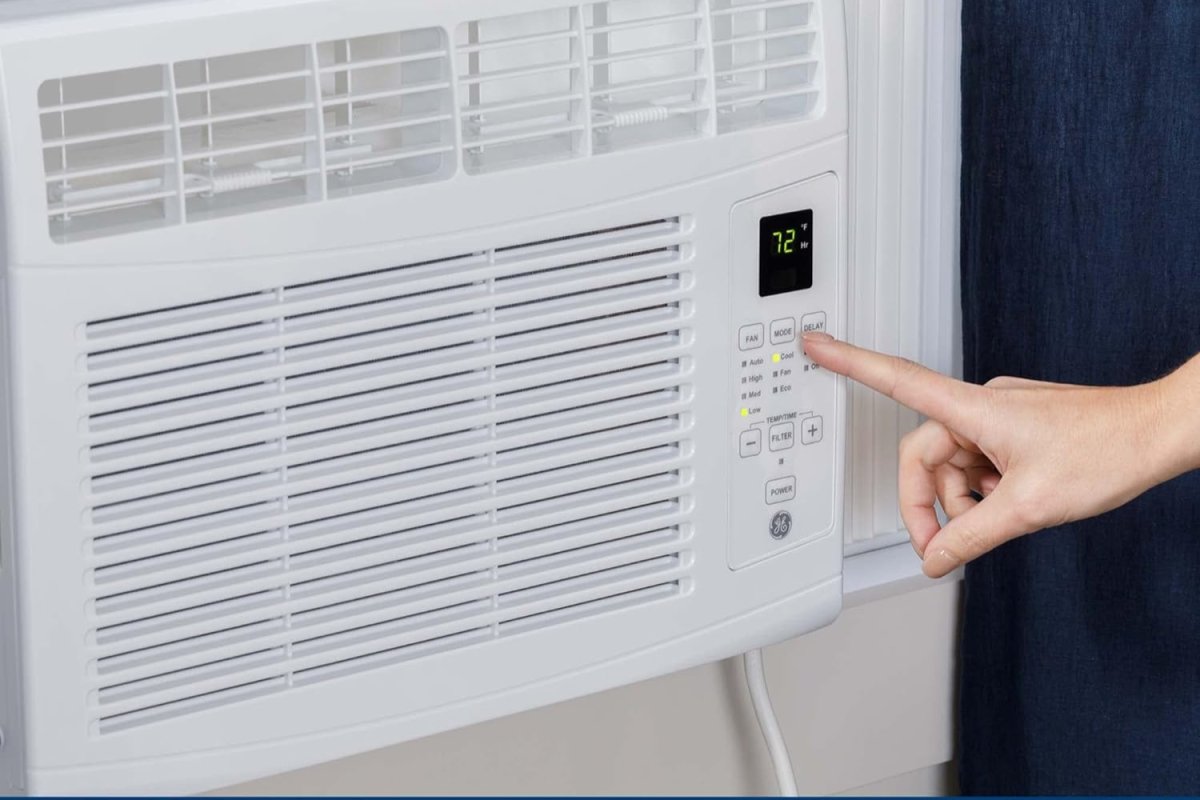
What to Consider When Choosing a Small Window Air Conditioner
Selecting the right size air conditioner and cooling capacity to meet the needs of the room is the most crucial element when selecting a small window air conditioner. However, other features are also important, including energy efficiency, temperature controls, and the number of operating modes.
Size/Cooling Capacity
Purchasing the proper size to suit the space is perhaps the most critical factor when shopping for a window air conditioning unit. If it’s too small, the air conditioner won’t be able to cool the space to the desired temperature. If it’s too large, the air conditioner will waste energy.
An air conditioner’s cooling capacity is indicated by BTUs, which is a measure of energy output. Window air conditioners range from 5,000 BTUs to over 20,000 BTUs. To determine what size is right for a particular room, match the BTU output to the square footage of the room. A 5,000 BTU air conditioner unit can handle up to 150 square feet, while an 18,000 BTU unit will cover up to 1,000 square feet. Most small window air conditioners range between 5,000 and 6,000 BTUs.
When selecting an air conditioning unit, it’s essential to make sure it can fit the window opening. Most small air conditioners can fit window openings from 22 inches to 34 inches wide with a minimum vertical opening of about 14 inches.
Temperature Settings and Display
Window-mount air conditioners have different types of controls for temperature settings. More affordable models have analog controls with temperature settings that range from 1 to 9, with 9 being the coldest.
Higher-end models have a digital or LCD display with precise controls that allow you to set the air conditioner to specific temperatures, typically ranging from the low 60s to the mid-80s (in degrees Fahrenheit). These window air conditioners have thermostats built into the main unit that read the temperature in the air and then use the results to regulate when the air conditioner turns on and off. Some models have thermostats in a remote control, which allows the unit to read the temperature in other parts of the room to more evenly cool a space.
Filter and Vents
Window air conditioners have filters that fit behind the slatted air intake on the front of the unit. These filters not only remove impurities that could harm the inner mechanical pieces in the air conditioner but also filter out air impurities, such as pollen, dust, and even some viruses, making the air in the room cleaner. These filters should be cleaned periodically by removing them and rinsing them under a faucet to remove the collected dust and dirt.
After the air in an air conditioner passes through the filter and is cooled in the condenser, a blower sends the chilled air back into the room through the vents at the top of the unit’s face. These vents are adjustable in four directions, allowing users to make adjustments to the airflow from the air conditioner to evenly cool the room.
Dehumidifier
All air conditioners remove humidity in the room simply by cooling warm, humid air via the compressor. A dehumidifier function uses the compressor just enough to remove moisture from the air by cycling the compressor on and off. While this mode won’t lower the temperature in the room, it does make the air drier and thus more comfortable. And since the compressor isn’t running full-time as it does in cooling mode, the dehumidifier mode uses less energy, making it a more economical way to make a room more comfortable.
Energy Efficiency
Air conditioners use a significant amount of energy to operate the condenser that cools the air that passes through it. Depending on its size, a window AC unit uses between 500 and 1,500 watts of electricity. If a small 500-watt window air conditioner runs for 8 hours a day, that translates to 120 kilowatt-hours of electricity each month. Considering the national average cost per kilowatt-hour of electricity is 12 cents, that translates to about $15 a month to cool a single room. Larger AC units cost more to operate.
Some window air conditioners are more efficient than others. The best way to compare models is to calculate an air conditioner’s Energy Efficiency Rating (EER) by dividing its BTU output by its wattage. The higher the number, the more energy efficient the air conditioner is. For example, a 12,000 BTU air conditioner that uses 1,200 watts would have an EER of 10 (12,000/1,200). An energy-efficient air conditioner has a rating of at least 9 or above. Energy Star–certified air conditioners have an EER of at least 12.
Additional Features
Window air conditioners include various operating modes and features that make them versatile, more energy efficient, and easier to use.
- Timers: Many units feature 24-hour timers that automatically turn them on or off after a certain amount of time has passed. This allows you to set the AC unit to turn off while not in use, saving energy and money, or to turn it on to make sure the space is cool when it’s time for bed.
- Modes: Many air conditioners include various modes that allow you to fine-tune the way they operate. These include energy-saver modes that cycle the compressor off and on to save energy, sleep modes that slowly increase the temperature a few degrees through the night to account for the natural decline in body temperature during sleep, and turbo modes for quickly cooling a hot space.
- Smart: High-end smart air conditioners are able to connect to a home’s Wi-Fi network, allowing the air conditioner’s temperature and modes to be controlled remotely via a smart device or digital assistant.
Noise Level
Unlike central AC units, which have their noisy compressors outside the home and air handlers tucked away in the attic space, window units have both pieces in a box that rests in a window. This means the noise of the unit is not muffled by walls.
The average window air conditioner produces about 60 decibels of noise; this is about the same volume as a normal conversation or an electric shaver. Some AC units have quiet options capable of dropping their noise output close to 50 decibels (or even less, though we weren’t able to reach those levels), which is similar to the sound of light traffic. Just keep in mind that the window AC unit is louder when working at or near its capacity, so it won’t produce as much cold air in quiet mode as it does in turbo mode.
Some window AC units feature innovative designs that muffle the sound of the condenser, reducing their noise output to around 40 decibels.
Installation
Of all the types of air conditioners—central, through the wall, and ductless—window air conditioners are by far the easiest to install. They don’t require cutting holes in a wall, complicated wiring, or brazing copper pipe fittings. Installation typically involves placing the unit into a window using a mounting kit that includes brackets attaching the air conditioner to the window sash and jamb.
Since window units don’t take up the entire width of the window opening, they include adjustable plastic panels that fill the voids in the window on either side of the unit. Weatherstripping installed between the sash, sill, jambs, and air conditioning unit help prevent air from escaping around the unit.
FAQs
Proper installation and maintenance of a small air conditioner are vital to keeping it performing efficiently. Ahead, learn more about how to get the most out of these appliances.
Window and room air conditioners differ in the way they vent hot air. Portable room air conditioners are freestanding appliances, often resting on wheels and requiring a hose that attaches to a window to vent hot air outside. A window air conditioner mounts inside the window, allowing it to vent hot air directly through the window.
Many small air conditioners are very energy efficient, with energy-efficiency ratings that are 11 or above. The most efficient small air conditioners have an Energy Star certification, which means they have an EER of at least 12.
While there are many options for sealing the space around an air conditioner, the best way is to use adhesive-backed weatherstripping to cover the spaces around the air conditioner and the window. You can also use rope caulk, which is similar in consistency to clay, to fill small gaps.
Take the following steps to clean a window air conditioner:
1. Begin by unplugging it.
2. Remove the case using a screwdriver.
3. Clean the drainpipe pan with soapy water to prevent mold from growing on it.
4. Use a vacuum to remove any dust or dirt that has collected inside the unit.
5. Spray the inside of the unit with a mild water-and-dish-detergent solution, and wipe with a clean cloth.
6. Open the case that covers the exterior side of the air conditioner and spray and wipe the condenser coils clean.
7. Reassemble the air conditioner; then remove and clean the reusable filter.
Meet the Tester
Tom Scalisi is a full-time DIY and construction writer for many of the largest websites in the industry, including BobVila.com, This Old House, Family Handyman, and Forbes. He also owns and operates a pest control blog, RiddaBugs.com. He spent years working in the trades and industrial building maintenance.
Additional research provided by Tony Carrick.

